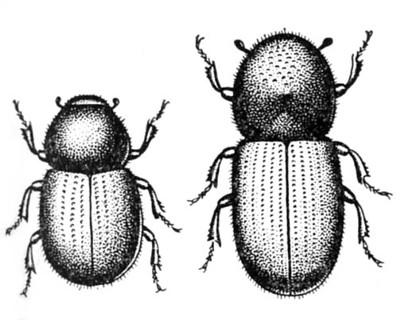Pests
Xyleborus dispar (F.) - European Shot-Hole Borer.
Systematic position.
Class Insecta, order Coleoptera, family Scolytidae, genus Xyleborus Eichh.Synonyms.
Apate dispar F.; Anisandrus aequalis Rtt.; A. swainei Drake; Bostrichus brevis Panz.; B. pallidus Panz.; B. ratzeburgi Kol.; B. tachygraphus Sahlb.; B. thoracicus Panz.; Scolytus pyri Peck; Xyleborus rugulosus Egg.; X. cerassi Egg.Biological group.
Pests of apple, apricot, peach, bird-cherry, pear, plum, walnut.Morphology and biology.
Body length, 3-3.5 mm in female, 2 mm in male. The body is short and broad, strongly convex and shining, mostly black-brownish; head is almost black; antennae and legs are yellow-brownish or yellow. Frons is convex, sparsely punctured, having smooth elongated carina and fine shagreenate sculpture. Antennal club is articulated. Pronotum is globular, strongly convex; its anterior margin has row of denticles; apical half of pronotum is covered with large denticles and with tiny denticles among large ones. Male pronotum is flattened and sloped distad. Scutellum is large, smooth and shining, variable in its color. Elytra are broad, weakly elongated, with distinct striae to the apex. Elytral slope is flattened, beginning behind middle, without tubercles and hollows.Distribution.
The species inhabits major part of Europe, Asia Minor, and North America. In the former USSR, it is widely distributed in the European part northward to forest-tundra, in the Caucasus, Western Siberia, and Kazakhstan.Ecology.
The species is monovoltine. It hibernates in adult stage inside galleries. Flight occurs at air temperature about 18°C. It is a polyphage. In nature it damages mainly softwood deciduous trees (e.g., Alnus incana, Populus tremula), rarely occurring on hardwood deciduous trees (e.g., Quercus robur, Juglans regia). The pest prefers young and middle-aged host-trees. In the beginning, a female bores initial gallery of 3-6 cm long perpendicularly to the axis of a trunk or branch. Then the gallery forks and extends along the annual ring on both sides of the initial gallery. Inside the gallery, the female gnaws small cavities for eggs. Hatched larvae feed on xylophagous fungi Ambrosiella hartigii Batra developing on wood sap. Adults of X. dispar contain the fungal spores in intestinal flora and spread them in galleries before coupling (symbiotic relationships). Larvae do not gnaw galleries. Death of xylophagous fungi causes the death of larvae soon. Colydium elongatum F. (Coleoptera, Colydiidae) is one of the predators of X. dispar.Economic significance.
The species damages sporadically, mainly in adult stage. The pest is common in apple tree orchards and on bird-cherry trees in forest belts within the steppe zone. It attacks depressed and healthy plants. In Dagestan, the pest damages walnut Juglans regia. Control measures include using fertilizations, pruning and burning of trees and branches infested by X. dispar; the use of trap trees and trap branches for adults. Pesticide treatment is necessary in case of high pest abundance during flight of adults. The Lindgren funnel trap is used for monitoring adult flight.Reference citations:
Alonso-Zarazaga M.A. 2007. Fauna Europaea. http://www.faunaeur.org/index.phpFrench J.R.J., Roeper R.A. 1975. Studies on the biology of the ambrosia beetle Xyleborus dispar (F.) (Coleoptera, Scolytidae). Journal of Applied Entomology 78 (3): 241-247.
Kostin I.A. 1960. Data on the fauna of bark beetles of Kazakhstan (Coleoptera, Ipidae). In: Galuzo I.G., ed. Proceeding of Zoological Institute of Kazakhstan. Vol. 11. Alma-Ata: Nauka, P. 129-136. (in Russian).
Kostin I.A. 1973. Dendrophagous beetles of Kazakhstan (Ipidae, Cerambycidae, Buprestidae). Alma-Ata: Nauka, 288 p. (in Russian).
Krivolutskaya G.O. 1965. Family Ipidae. In: Bei-Bienko G.Ya., ed. Keys to the insects of the European part of the USSR. V. 2. Moscow & Leningrad: Nauka, p. 622-639. (in Russian).
Krivolutskaya G.O. 1996. Family Scolytidae (Ipidae). In: Ler P.A., ed. Keys to insects of the Far East of the USSR. V. 3. Coleoptera, or beetles. Part 3. Vladivostok: Dal'nauka. p. 312-317 (in Russian).
Kryzhanovskii O.L. 1974. Family Scolytidae. In: Kryzhanovskii O.L., ed. Insects and mites . pests of agricultural plants. V. 2. Coleoptera. Leningrad: Nauka, p. 293-301 (in Russian).
Mandelshtam M.Yu. 2001. Scolytidae of Lenigrad Region. St.Petersburg: http://www.zin.ru/Animalia/Coleoptera/rus/scolspb.htm
Mandelshtam M.Yu. & Popovichev B.G. 2000. Annotated list of bark beetles (Coleoptera, Scolytidae) of Leningrad Region. Entomologicheskoe obozrenie 79(3): 599-618. (in Russian).
Nikitskii N.B. 1980. Predatory insects of bark beetles and their ecology. Moscow: Nauka. 237 p. (in Russian).
Petrov A.B. 2005. Fauna of bark-beetles (Coleoptera: Scolytidae) of Daghestan. Russian Entomol. Journal 14(3): 217-222. (in Russian).
Prokof.ev, M.A. 1987. Siberian orchard protection against pests. Moscow: Rossel.khozizdat, 239 p. (in Russian).
Samedov N.G. 1963. Fauna and biology of beetles injuring agricultural plants in Azerbaijan. Baku: AN Azerb. SSR. 384 p. (in Russian).
Silfverberg H. 1992. Enumeratio Coleopterorum Fennoscandiae, Daniae et Baltiae. Helsinki-Helsingfors: Helsingin Hyonteisvaihtoyhdistys. 94 p.
Stark V.N. 1952. Bark-beetles. Coleoptera. In: Shtakel'berg A.A., ed. Fauna of the USSR. V. 31. Moscow & Leningrad: AN SSSR. 462 p. (in Russian).
Vasil.ev V.P. & Livshits I.Z., 1958. Pests of fruit crops. Moscow: Gosizd. Sel.khoz. lit. 392 p. (in Russian).
Yakovlev E.B., Shorokhov, V.V. & Gorbunova V.N. 1986. Data to the fauna of xylophagous beetles of Karelia. In: Yakovlev E.B. & Uzenbaev S.D., eds. Fauna i ekologiya chlenistonogikh Karelii. Petrozavodsk: Karelian filial AN SSSR. (in Russian).


